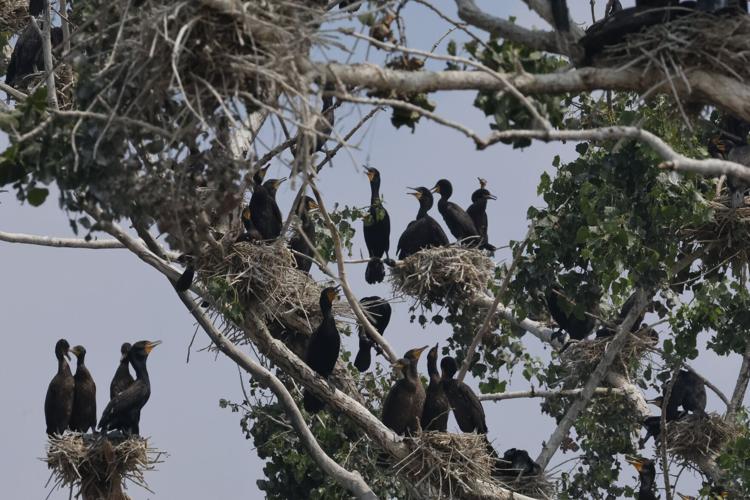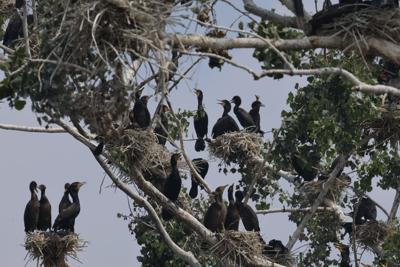The number of double-crested cormorant nests on the ÎÚŃ»´«Ă˝ Islands has quadrupled since last year, despite strenuous efforts to redirect the birds back to the main flock in Tommy Thompson Park.
“The cormorants are winning,” said ÎÚŃ»´«Ă˝ Island Community Association co-chair Tony Farebrother, adding that the situation is “worrisome.”
The birds are nesting in increasing numbers on a peninsula on Centre Island, in an area off-limits to the public. Their guano is toxic and kills the trees where they nest or roost in numbers. The trees turn a ghostly white and die.Ěý
Because cormorants live on fish, their guano produces an overpowering odour wherever they congregate.
The number of cormorant nests on Centre Island grew from 1,200 in 2024 to 4,500 nests this year, according to the ÎÚŃ»´«Ă˝ and Region Conservation Authority’s Karen McDonald, tasked with convincing the birds to relocate.
“These birds are driven to nest,” said McDonald, the TRCA’s senior manager, ecosystem management restoration.
“As soon as we remove a nest, they immediately start rebuilding it.”
Cormorants tend to avoid areas of human activity, like residential neighbourhoods or the busy tourist attractions on the islands. But some boaters and local business operators say the flock has already grown too large and is putting the future of the islandsĚý— one of the city’s most popular tourist attractions and a rare expansive green space for city dwellersĚý— in peril.
“Regrettably, a choice has to be made as to whether ÎÚŃ»´«Ă˝ Island Park is for people or cormorants,” said Bill Duron, executive chairman of York Bay Marine Corp., operators of the ÎÚŃ»´«Ă˝ Island Marina, Island Yacht Club and Hanlan’s Point Dock Wall.
The flock on Centre Island is now so large that the smell of their guano wafts over the yacht club and marinaĚýwhen the wind is from the south. Business at the Hanlan’s Point dockwall, where visiting boaters can pay to moor, is down 25 per cent, said Duron, adding that revenues from the dockwall are shared with the city.
The birds have begun moving across the narrow strait of water between Centre Island and Mugg’s Island and are roosting in numbers behind Hanlan’s Beach.
Cormorants build well-constructed nests, 25 to 30 metres high in the tree canopy.
“It’s not like you can flip them out of the trees,” said McDonald. “You really have to work at them.”

Cormorants’ guano produces an overpowering odour wherever they congregate.
Lance McMillan/ÎÚŃ»´«Ă˝ StarTRCA workers use long forestry poles to dislodge the nests; a giant slingshot mechanism that launches weights at the nests; and a new technique called line-flossing, which involves throwing a line over the nests and using a flossing manoeuvre to dislodge them.
The TRCA had 23 teams this year, working daily from sunrise to evening, from late March to mid-June.
One tree set a record with 179 nests.
Now that the nesting stage is over, the TRCA is focused on scaring cormorants from roosting areas, and it has built artificial nesting structures in Tommy Thompson Park to lure them back.
The problem is that the ÎÚŃ»´«Ă˝ Islands provide an ideal habitat for the speciesĚý— a forest of perfect maturity and height for them to build their nests, easy access to fish, and in some areas, little disruption from humans.
“We can move this colony,” said McDonald. “It’s just taking longer than we thought.”

ÎÚŃ»´«Ă˝ and Region Conservation Authority workers use poles to dislodge well-constructed cormorant nests in May.
TRCASince recovering from the brink of extinction in the 1990s, cormorants have swelled in numbers, and culling has been used to control their populations in places like Point Pelee National Park, a practice that has been met with objections from the Animal Alliance of Canada.
McDonald says culling is not being considered in ÎÚŃ»´«Ă˝, aĚýposition supported by waterbird and wildlife management expert Prof. Gail Fraser, at York University’s Faculty of Environmental and Urban Change.Ěý
“It was never going to be a quick fix. It’s a complicated situation,” said Fraser, who estimates it will take five years to move them.
Culling can also result in unintended consequences, said Fraser, pointing to a in the Pacific Northwest. Authorities were trying to prevent the birds from catching too many salmon. The flock moved instead to a bridge connecting Washington and Oregon, filling it with nests and coating it with guano.
While there are more cormorants perching around the edge of the ÎÚŃ»´«Ă˝ Island airport, Michael MacWilliam, director, airport operations, said they are not presenting a huge problem.
Cormorants tend to be low-flying, and do not interfere with airport operations as much as Canada geese.Ěý
They are being well-controlled, along with other birds, by existing measures, which include using noisemakers, and giant inflatables like the ones used at used-car lots, which act as scarecrows.
They are only deployed occasionally, to prevent the birds around the airport from becoming habituated, said MacWilliam.
McDonald said people shouldn’t get too close to the flock because cormorants can host a number of diseases and parasites that can be transferred to humans, including avian influenza.
































To join the conversation set a first and last name in your user profile.
Sign in or register for free to join the Conversation